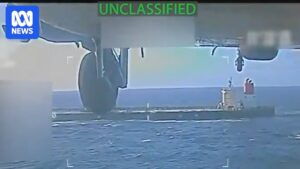
A significant milestone was achieved at the Point Mugu Sea Range in California as Boeing conducted the first developmental flight-test of its redesigned Harpoon Block II Update (HIIU) anti-ship missile. This inaugural test marks a pivotal step as the program edges closer to production, underscoring the missile’s evolving role in modern naval warfare.
The Harpoon Block II Update represents a near-total redesign aimed at addressing obsolescence issues, a move driven by growing global interest in the Harpoon system. According to Boeing officials, the redesign incorporates state-of-the-art hardware, software, and fuel enhancements to boost the missile’s performance and lethality.
Evolution of the Harpoon Missile
Since its introduction in 1977, the Harpoon anti-ship missile has been a staple in military arsenals worldwide, valued for its versatility as an air, surface, and submarine-launched weapon. The latest iteration, the Harpoon Block IIU, builds upon the legacy of the Harpoon Block II, which itself integrated technologies from Boeing’s Joint Direct Attack Munition and Standoff Land Attack Missile.
The Harpoon Block II has been successfully exported to several nations, including India, South Korea, Qatar, and Australia, highlighting its global reach and strategic importance. The Block IIU refreshes the internal hardware to meet the evolving demands of modern warfare, ensuring the missile system remains relevant in various configurations.
Successful Test and Collaborative Efforts
The recent test, conducted from an F-15SA aircraft, was a collaborative effort involving multiple teams, including Cruise Missile Systems, F-15 and Boeing Test & Evaluation, along with the U.S. Navy. According to Boeing, the test successfully met objectives for propulsion, guidance, navigation, and control systems, demonstrating the missile’s desired aerodynamic performance.
“Completing this test was especially meaningful because all the teams involved were able to work together and accomplish a shared mission to help the U.S. and its allies,” said Joe Gentile, F-15 Test Engineer.
This development follows ongoing modernization efforts as part of a service life extension program (SLEP) for the Harpoon missile. RTX, as the sole designer, developer, and manufacturer, is tasked with providing supplies and services for the SLEP upgrade, ensuring the continued viability of Harpoon seekers for production.
Global Implications and Future Prospects
The successful test of the Harpoon Block IIU not only signifies technological advancement but also carries significant geopolitical implications. As nations increasingly seek to bolster their naval capabilities, the demand for advanced anti-ship missiles like the Harpoon is expected to rise.
Deliveries of the overhauled Block IIU Harpoons are anticipated to commence in 2026, signaling a new chapter in the missile’s storied history. The move represents Boeing’s commitment to extending the production run of the Harpoon, ensuring it remains a formidable asset in naval warfare for years to come.
Meanwhile, experts suggest that the Harpoon’s continued evolution is crucial for maintaining strategic balance in key maritime regions. As global tensions fluctuate, the ability to deploy advanced missile systems could prove decisive in both deterrence and conflict scenarios.
As Boeing prepares to transition from testing to production, the Harpoon Block IIU is poised to reinforce its position as a cornerstone of naval defense. The successful test at Point Mugu is not just a technical achievement but a testament to the collaborative efforts of military and industry partners dedicated to advancing defense capabilities.






